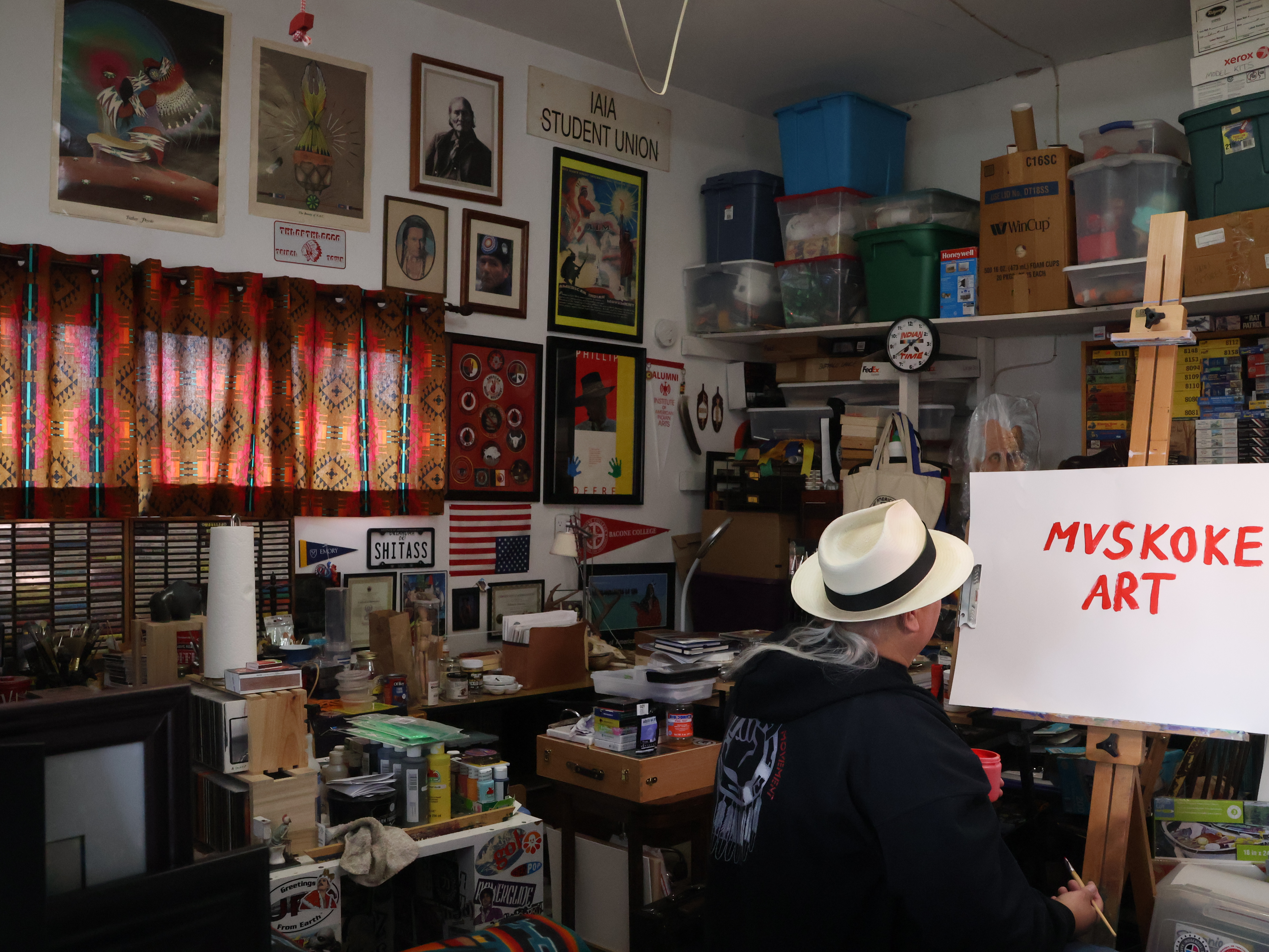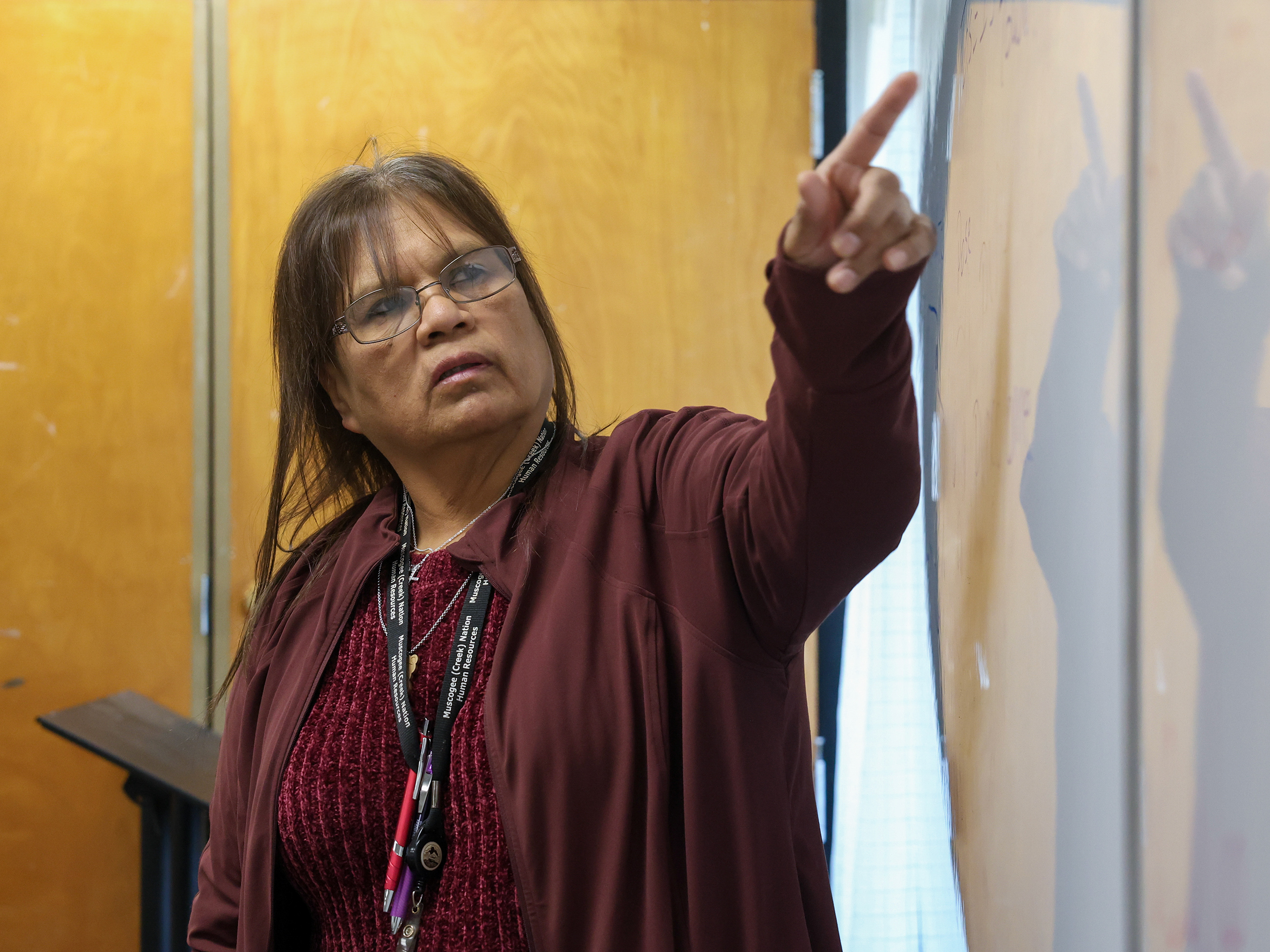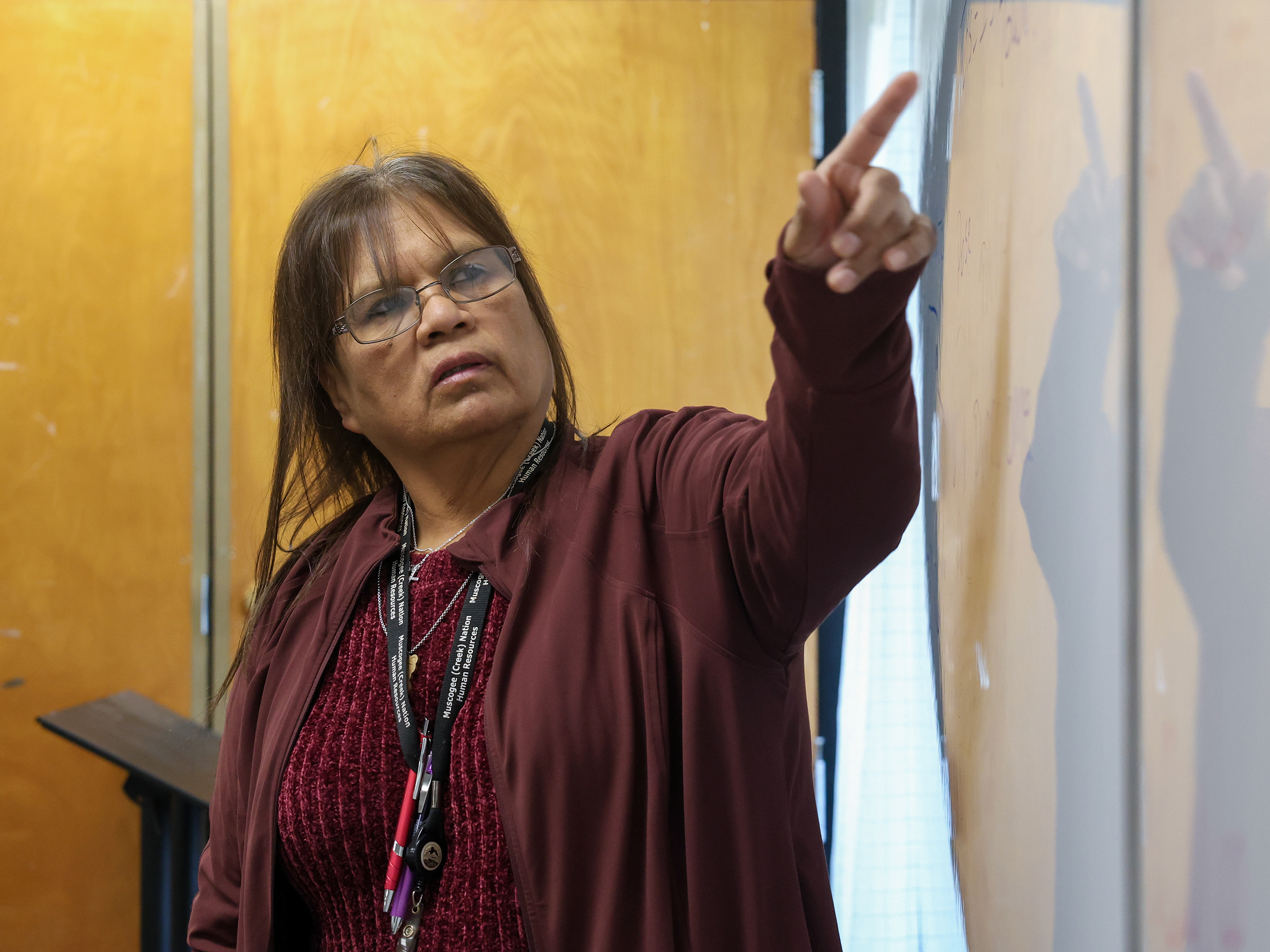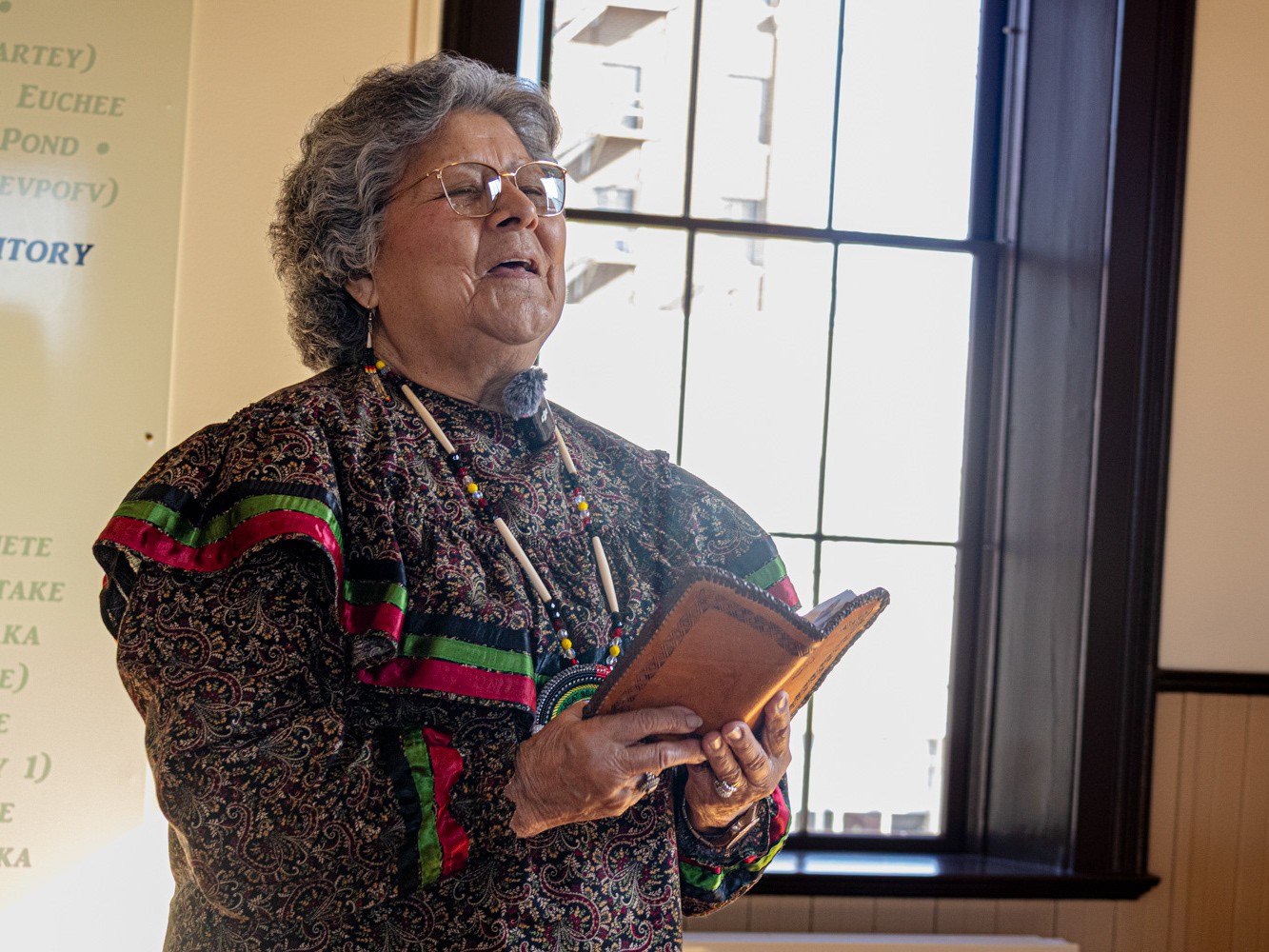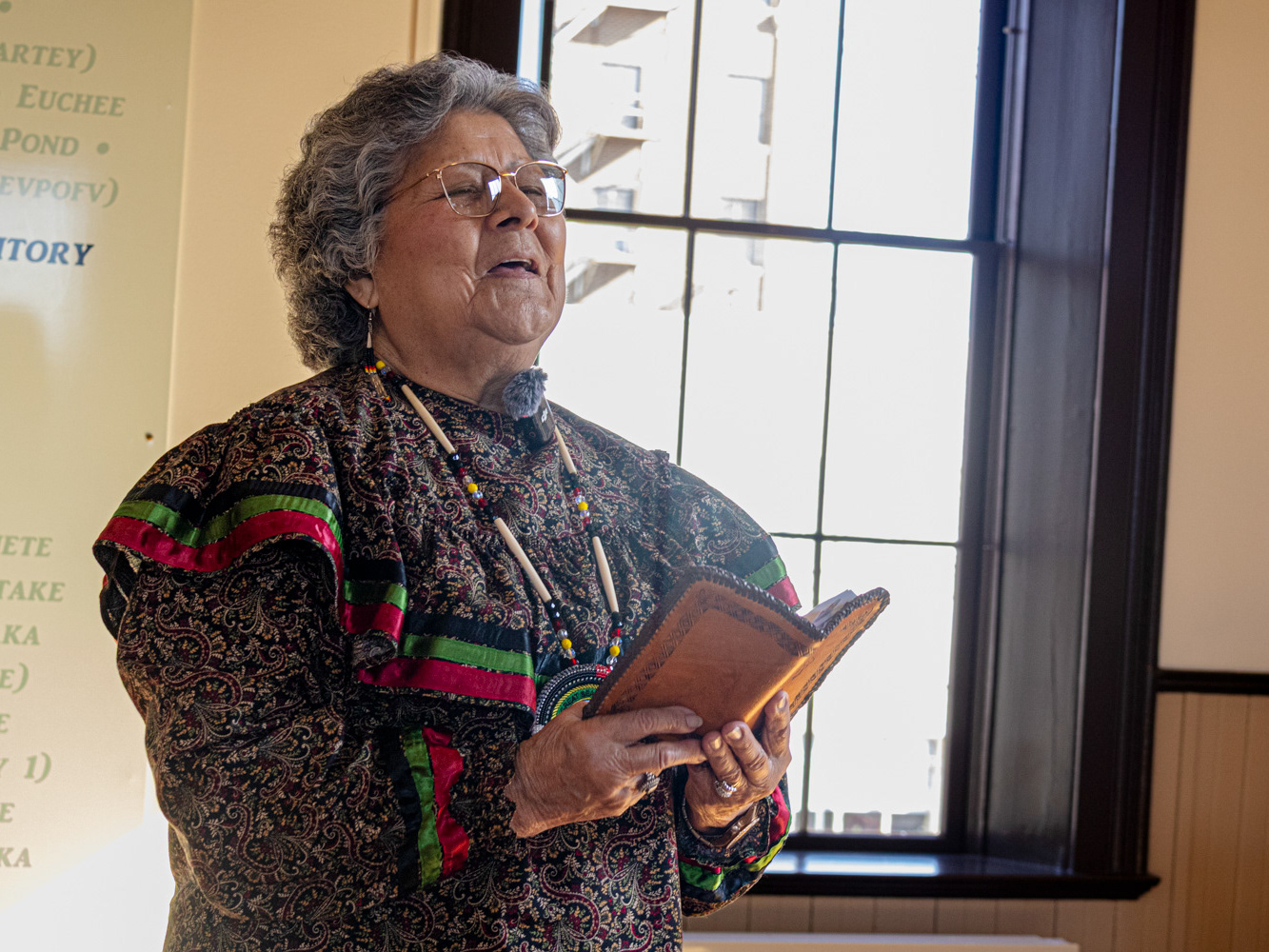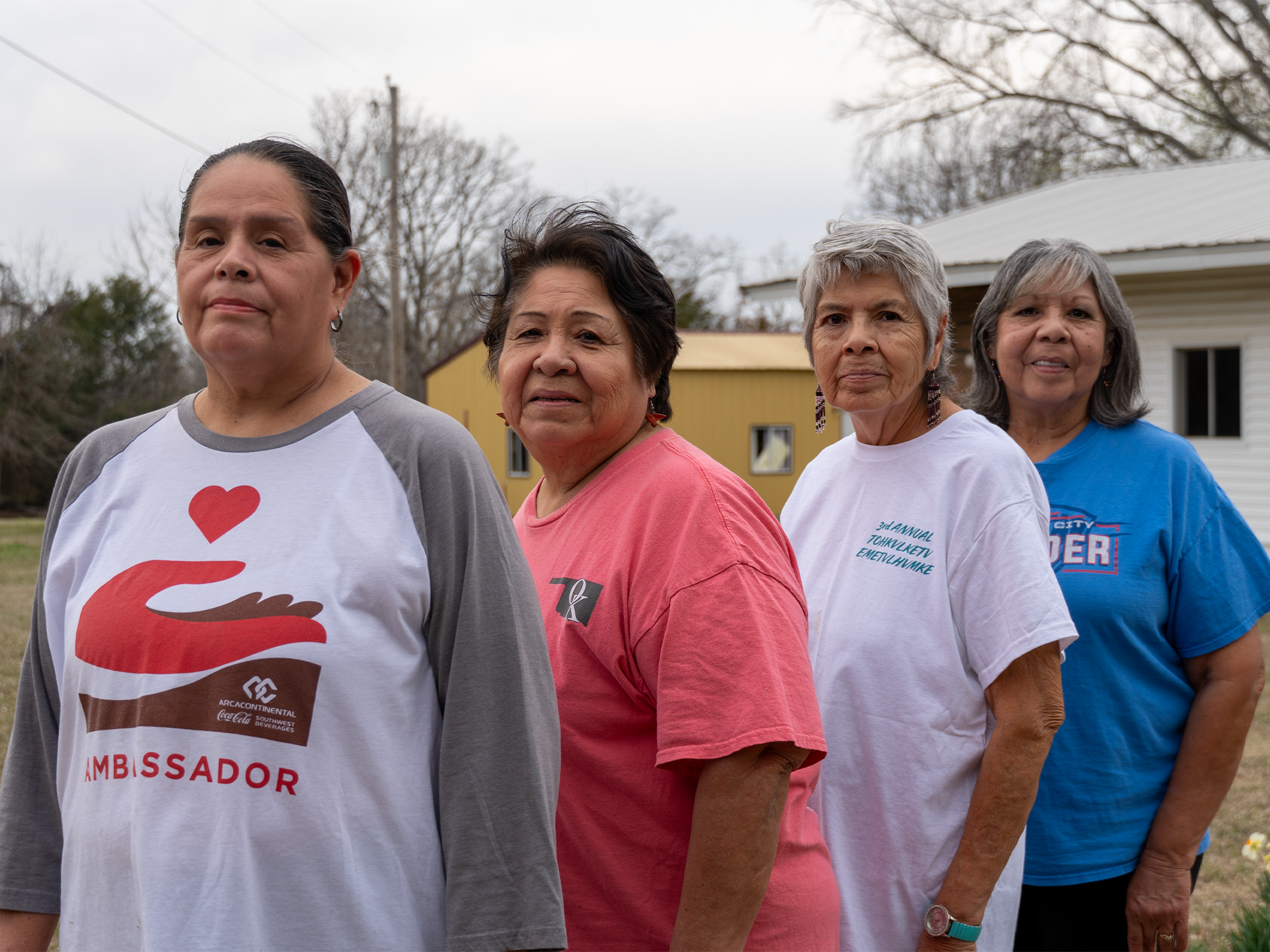Dana Tiger Prays in her Prayer Circle in Muskogee, OK. Riley Morris
MUSKOGEE, OK — At the end of a short road in a corner of Muskogee, the Tiger Art Gallery sits in an unobtrusive row of buildings. The small parking lot is laced with cracks showing green stems crawling through. The building is set low into the ground with an old concrete staircase.
A narrow pathway winds past odd items and an old ambulance in the side yard and into the cluttered work space, filled from floor to ceiling with paintings, supplies, T-shirts, cases, tables, chairs, easels and a great big fluffy cat.
Standing at a desk is the gallery’s namesake, a whirlwind of an artist named Dana Tiger.
“I think of this as the center of the world,” she says.
She welcomes visitors like old friends, talking about anything and everything. The gallery seems to match her perfectly with its colorful aura. It’s a small room, filled to the brim with memorabilia. The walls are covered in her art. A cat is wandering around and meowing.
“He’s interrupted so many interviews” Dana says while introducing Fat Cat.
Tiger, 63, is a world renowned artist, known for her portrayals of strong women and for using her art as a medium for activism and awareness. She has been painting since she was 24 and was inducted into the Oklahoma Women’s Hall of Fame in 2001 for her work. She has lived with Parkinson’s disease since 1995 and has adapted her painting style to fit her body’s movements. She says her key to life is laughter.
The Beginning
Her father was legendary artist Jerome Tiger, who died from an accidental shooting when she was only 5. Her mother, Peggy Tiger, created the Jerome Tiger Art Company to remember him.
“[Growing up], we were surrounded by his art [and] that kept him close to us: me, my sister, and my brother,” she says, looking off to the side, seemingly in deep thought.
Dana says she never wanted to be an artist. She went to school for political science for three years. After her boyfriend was killed, however, she dropped out and went back home. She turned to alcohol for the following year to cope.
“Painting your thoughts and feelings – you can either go that route or use drugs and drink – and I had done that before – and art is what I replaced that with,” she says. “I can always remember that I quit drinking when I was 24 and made a promise that I would paint or draw every day for a year to see what would happen.”
She looks off to the side for a moment once more, hands shaking from the Parkinson’s.
The Art
Dana started painting after being inspired by her father. She says at first she copied his style, such as his depictions of the Trail of Tears. She took inspiration from his knowledge. His parents were fluent native speakers of Muskogee and he grew up surrounded by the culture.
This original paternal inspiration shows itself in most of her art. She talks about one painting in particular, titled “Freedom to Choose.” There is a woman sitting, head in fist as she looks off in thought. The bottom half of the painting has deteriorated from being passed around for several decades.
Dana Tiger’s “Freedom to Choose." Riley Morris
“In our cultural, tribal way, the women decide for their own body what was going to happen. It wasn’t a big legislative decision,” she says. “And, you know, they had to disempower the women before they took control of the whole land base that we had.”
She also said her brother, Chris, was a similar inspiration for her. He was murdered in 1990.
“My brother and my father had true vision. They loved art, they loved doing it. I had that turmoil [with it].”
Dana talks a lot about her mother, Peggy, and sister, Lisa, noting that they are some of the biggest inspirations for her art. She boasts about how strong her mother was, adamantly stating that she could do anything. She speaks about her almost reverently.
“She always believed in me, too, even though I was a wild child,” she laughs.
She describes her mother’s love of books, her brilliant mind, and all the hard work she put into taking care of the family.
“An earthquake could happen and the street could fall into the depths of the earth and [it] wouldn’t faze her. She was so tough.” Dana grins. She’s been laughing as she spoke, seeming to find joy in the remembrance.
Her mom passed away young, Dana says. She had been in a wreck and was in the hospital on life support. But Peggy was able to make it home before she died. Dana remembers that night vividly.
Part of Dana Tiger’s Painting for Joy Harjo’s book “Washing My Mother’s Body: A Ceremony of Grief.” Riley Morris
Dana gestures to a few lines on a painting sitting next to her. She painted it for Joy Harjo’s book “Washing My Mother’s Body: A Ceremony of Grief.”
“These trees right here symbolize the trees in my front yard at the house she built on the west side of my bedroom that I grew up in. And the day she died – that night when they were taking her body out for the last time, she was leaving the house, this star shown between those trees.”
She recalls the Larry McMurtry novel “The Evening Star” and the movie based on it, which makes her cry every time she watches it.
“And there that star came to me, I swear to God, that night that she left. And how, how effing powerful is that? I mean, that's my mother just being shining on for me. The day she left the house, she was still there, and would always be there.”
She speaks of her sister, Lisa, with respect. Her sister also has Parkinson’s, but in addition is HIV+. She lives in Santa Fe, New Mexico. Dana describes Lisa as one of the strongest people she knows and the source of inspiration for most of her artwork. When Lisa was diagnosed with HIV, Dana says she didn’t know what was going to happen.
“I asked her what could I do? I’d do anything when she got AIDS cause I didn’t know what – I thought she was gonna die immediately or something.” She looks at a poster in the corner that says “HIV/AIDS: It’s Not Over,” which she designed in her sister’s honor.
An HIV/AIDS poster in the Tiger Gallery. Riley Morris
All Lisa wanted was for Dana to marry Donnie – her now husband of 32 years – and let her be the best woman at the wedding. Despite Dana’s previous pride in not getting married, she followed her sister’s wishes. She says she doesn’t regret it.
Dana was diagnosed with Parkinson's in 1999 but had been experiencing symptoms since 1995. Parkinson’s is a progressive neurological disorder that mainly affects movement in a way that causes tremors, balance problems, and other similar symptoms. There is no known cure; however, Dana expresses that she believes she can find a cure through holistic remedies. When she stops painting, she wants to do more gardening to pursue this.
Dana summarizes her experiences both with living with Parkinson’s and receiving her diagnosis. “I just thought, you know, that’s life. But it was a relief to figure out I had something that had a name and they had a medication that could help me be somewhat normal.” She laughs before continuing. “I do not know what normal is like.”
Because of her Parkinson’s diagnosis, Dana had to find a new way to paint. She adopted a more free-flowing style that coincides with her body movements. She describes it as “just flinging paint around.”
“It worked. People loved it better than they loved my other stuff!” She continues by saying every painting she’s made has sold. She says that if her Parkinson’s had prevented her from painting with her hands, she would just “scoot [her] body across the floor and make something.” She laughs, saying, “when you want to create something, you find a way.”
The Future
Another side of the family business is selling T-shirts with the Tiger logo on them. Her son, Lisan, prints them in a back room at the gallery. Her mother and uncle started the company and it gained huge traction in the mainstream. The business provided for Dana and her siblings growing up. Dana is the eldest Tiger now and she is in charge of the company that her mother and uncle worked so hard for. She believes, however, that it isn’t all on her now, although it was for a time. She, her husband, and her children all work to keep the family’s art and business alive.
“Everybody kind of comes together and some beauty flows. I love that.”
Her daughter, Christie, named in honor of Dana’s brother, and her son, Lisan, named in honor of Dana’s sister, are both award-winning artists. Christie’s specialty is drawing and painting and Lisan’s specialty is sculpture.
“It’s really not about me anymore. But I'm so lucky, I'm so thankful, [that I have] such great beauty around me.”
Dana is confident that her children will be able to be able to take care of themselves like everyone that came before them.
“I just really look [forward to] the day that they let mama retire!” She laughs.
Recently, an award winning short film was made about Dana Tiger’s life and legacy. It won an award at the Sundance Film Festival.
“It’s setting for the future in a good strong way that's gonna take care of what we have to say ’cause we need those messages to get out there that we gotta control our own destiny, through food, through art, through stories, we gotta sing it and paint it and live it.”
The director of the film, Loren Waters, hopes to get grant money to build another gallery nearby the original to showcase Tiger art and be a welcoming place for people from all over the world.
The Legacy
The sun blinds us as we walk outside. She leads us down the small path in front and past the side yard to a small field. The path in the grass is worn down from years of foot traffic.
It seems several stones are missing from the walkway. The field is empty except a few cedar trees, a far-away stickball field, and her prayer circle. It’s on a mound of sticks and brush. Half-made walls surround it, forming a circle around three large branches forming a point over where she sits in front of a small circle of rocks.
She lights pieces of cedar from the trees on the edge of the property in a seashell. She waves it over herself, staring up into the sky every once in a while with an ethereal expression on her face.
She invites us to join her and allows us to wave cedar smoke over ourselves. The ground is solid, packed down firmly into a large mound. She tells us that on a certain date in October, the sun is positioned perfectly to shine directly on the mound. She’s made it into her own mini holiday. She shows us her paper pile where she creates fertilizer from trash. She shows us the young peach trees near the front of her yard and tells us how their seeds are from the trees her ancestors carried over on the Trail of Tears from Georgia.
She has kept this land that her mother left to her and will carry on the family’s legacy here.
“It's good when we finally realize what we are, what we have within us and can do. And I love it when my art makes people see that within themselves.”
